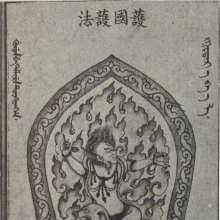Kshetrapala, Kṣetrapāla, Kshetra-pala: 15 definitions
Introduction:
Kshetrapala means something in Hinduism, Sanskrit, Jainism, Prakrit, the history of ancient India, Marathi. If you want to know the exact meaning, history, etymology or English translation of this term then check out the descriptions on this page. Add your comment or reference to a book if you want to contribute to this summary article.
The Sanskrit term Kṣetrapāla can be transliterated into English as Ksetrapala or Kshetrapala, using the IAST transliteration scheme (?).
Images (photo gallery)
In Hinduism
Purana and Itihasa (epic history)
Source: archive.org: Puranic EncyclopediaKṣetrapāla (क्षेत्रपाल).—Kṣetrapāla is consecrated on the South East corner of the temple, for protecting the villages and cities. This is a large image with three eyes. There are figures which are Sāttvika, Rājasa and Tāmasa (having the attributes goodness, ostentatiousness and sloth). In some places figures having two or four or eight hands are seen. It is presumed that this deity is a portion of Śiva. It is stated in Agni Purāṇa, Chapter 51 that Kṣetrapālas should be figures having trident in the hand.
Source: archive.org: Shiva Purana - English Translation1) Kṣetrapāla (क्षेत्रपाल) refers to a group of deities who together with the nine Durgās participated in Vīrabhadra’s campaign against Dakṣa, according to the Śivapurāṇa 2.2.33. Accordingly, as Brahmā narrated to Nārada:—“Mahākālī went ahead for the destruction of Dakṣa accompanied by nine Durgās [...]. Eager in executing the command of Śiva, they accompanied the marching heroes—[viz., Kṣetrapālas] and set out quickly for the destruction of Dakṣa’s sacrifice”.
2) Kṣetrapāla (क्षेत्रपाल) is the name of a deity who fought on Vīrabhadra’s side in his campaign to destroy Dakṣa’s sacrifice, according to the Śivapurāṇa 2.2.37. Accordingly:—“[...] Vīrabhadra took up all the great miraculous weapons for his fight with Viṣṇu and roared like a lion. [...] Desirous of gobbling up the leading Devas, Kālī split them and drank their blood. Kṣetrapāla too did the same. Then Viṣṇu, the slayer of enemies and who was excessively brilliant, hurled his discus and fought with them. The discus seemed to burn the ten directions. Kṣetrapāla saw the discus coming on. He ran to the place and bravely caught hold of it”.
Source: Cologne Digital Sanskrit Dictionaries: The Purana IndexKṣetrapāla (क्षेत्रपाल).—Attendants to Śiva;1 Kārtavīrya known as.2

The Purana (पुराण, purāṇas) refers to Sanskrit literature preserving ancient India’s vast cultural history, including historical legends, religious ceremonies, various arts and sciences. The eighteen mahapuranas total over 400,000 shlokas (metrical couplets) and date to at least several centuries BCE.
Arthashastra (politics and welfare)
Source: Wisdom Library: ArthaśāstraKṣetrapāla (क्षेत्रपाल) refers to a “superintendents of cultivated lands” and represents an official title used in the political management of townships in ancient India. Officers, ministers, and sovereigns bearing such titles [eg., Kṣetrapāla] were often present in ancient inscriptions when, for example, the king wanted to address his subjects or make an important announcement.

Arthashastra (अर्थशास्त्र, arthaśāstra) literature concerns itself with the teachings (shastra) of economic prosperity (artha) statecraft, politics and military tactics. The term arthashastra refers to both the name of these scientific teachings, as well as the name of a Sanskrit work included in such literature. This book was written (3rd century BCE) by by Kautilya, who flourished in the 4th century BCE.
Shaktism (Shakta philosophy)
Source: Google Books: ManthanabhairavatantramKṣetrapāla (क्षेत्रपाल) refers to the “guardians”, according to the Manthānabhairavatantra, a vast sprawling work that belongs to a corpus of Tantric texts concerned with the worship of the goddess Kubjikā.—[...] In the enclosures around the core [of the kramamaṇḍala], goddesses and their consorts are worshipped who are, effectively, protectors and sustainers of the Krama. These are the Mothers (mātṛkā), worshipped on the eight petals of a lotus. Outside them are the thirty-two goddesses who govern the energies of the thirty-two syllables of Kubjikā's Samayā Vidyā. In some versions of the maṇḍala, sixty-four sacred sites, along with the Yoginīs and guardians (kṣetrapāla) who reside there, are worshipped on the petals of a third lotus. These three represent the Fire, Moon and Sun.

Shakta (शाक्त, śākta) or Shaktism (śāktism) represents a tradition of Hinduism where the Goddess (Devi) is revered and worshipped. Shakta literature includes a range of scriptures, including various Agamas and Tantras, although its roots may be traced back to the Vedas.
In Jainism
General definition (in Jainism)
Source: archive.org: The Jaina IconographyKṣetrapāla (क्षेत्रपाल) is the name of a deity commonly depicted in Jaina art and iconography.—In the Śvetāmbara books, we meet with two descriptions of this god [viz., Kṣetrapāla]. From one, we gather he has twenty hands with many weapons, matted hair, a snake as his holy thread and rides a dog. He is surrounded by Ānanda and other Bhairavas and leads the sixty-four Yoginīs. The other description makes him six-handed, the attributes being a club, noose, Ḍamaru, bow, goad and Geḍika?.
Kṣetrapāla is a Bhairava and seems to be the master of the Yoginīs. As the name suggests, he is the deity whose functionis to protect the field. Hence, probably, he has the dog, who might watch the field and help his master by guarding it against any aggressor. The Bhairavas of Brahmanism, such as the Kālabhairava and Vaṭukabhairava are always associated with a dog. In fact, the relation of Kṣetrapāla with Vaṭukabhairava has been clearly mentioned of in the Jaina texts.

Jainism is an Indian religion of Dharma whose doctrine revolves around harmlessness (ahimsa) towards every living being. The two major branches (Digambara and Svetambara) of Jainism stimulate self-control (or, shramana, ‘self-reliance’) and spiritual development through a path of peace for the soul to progess to the ultimate goal.
India history and geography
Source: Cologne Digital Sanskrit Dictionaries: Indian Epigraphical GlossaryKṣetrapāla.—(IE 8-3; EI 17; HD), same as Kṣetrapa. Cf. Ep. Ind., Vol. XVII, p. 321. Note: kṣetrapāla is defined in the “Indian epigraphical glossary” as it can be found on ancient inscriptions commonly written in Sanskrit, Prakrit or Dravidian languages.

The history of India traces the identification of countries, villages, towns and other regions of India, as well as mythology, zoology, royal dynasties, rulers, tribes, local festivities and traditions and regional languages. Ancient India enjoyed religious freedom and encourages the path of Dharma, a concept common to Buddhism, Hinduism, and Jainism.
Languages of India and abroad
Marathi-English dictionary
Source: DDSA: The Molesworth Marathi and English Dictionarykṣētrapāla (क्षेत्रपाल) [or ळ, ḷa].—m (kṣētrapāla S) The tutelar divinity of a place; the local and guardian deity of.
Marathi is an Indo-European language having over 70 million native speakers people in (predominantly) Maharashtra India. Marathi, like many other Indo-Aryan languages, evolved from early forms of Prakrit, which itself is a subset of Sanskrit, one of the most ancient languages of the world.
Sanskrit dictionary
Source: DDSA: The practical Sanskrit-English dictionaryKṣetrapāla (क्षेत्रपाल).—
1) a man employed to guard a field.
2) a deity protecting fields.
3) an epithet of Śiva.
Derivable forms: kṣetrapālaḥ (क्षेत्रपालः).
Kṣetrapāla is a Sanskrit compound consisting of the terms kṣetra and pāla (पाल).
Source: Cologne Digital Sanskrit Dictionaries: Benfey Sanskrit-English DictionaryKṣetrapāla (क्षेत्रपाल).—m. 1. a field-guard, [Pañcatantra] 224, 5. 2. the tutelary deity of a field, 174, 15.
Kṣetrapāla is a Sanskrit compound consisting of the terms kṣetra and pāla (पाल).
Source: Cologne Digital Sanskrit Dictionaries: Cappeller Sanskrit-English DictionaryKṣetrapāla (क्षेत्रपाल).—[masculine] = kṣetrapa.
Source: Cologne Digital Sanskrit Dictionaries: Monier-Williams Sanskrit-English Dictionary1) Kṣetrapāla (क्षेत्रपाल):—[=kṣetra-pāla] [from kṣetra] m. a man employed to guard fields, [Pañcatantra; Mārkaṇḍeya-purāṇa] etc.
2) [v.s. ...] a tutelary deity (their number is given as 49 [Prayogāmṛta]), [Pañcatantra iii; Agni-purāṇa; Pañcadaṇḍacchattra-prabandha]
3) [v.s. ...] Name of Śiva
[Sanskrit to German]
Sanskrit, also spelled संस्कृतम् (saṃskṛtam), is an ancient language of India commonly seen as the grandmother of the Indo-European language family (even English!). Closely allied with Prakrit and Pali, Sanskrit is more exhaustive in both grammar and terms and has the most extensive collection of literature in the world, greatly surpassing its sister-languages Greek and Latin.
Kannada-English dictionary
Source: Alar: Kannada-English corpusKṣētrapāla (ಕ್ಷೇತ್ರಪಾಲ):—
1) [noun] a man guarding or employed to guard a field.
2) [noun] Bhairava, the deity that protects fields.
Kannada is a Dravidian language (as opposed to the Indo-European language family) mainly spoken in the southwestern region of India.
See also (Relevant definitions)
Partial matches: Kshetra, Paala, Pala.
Starts with: Kshetrapalaka, Kshetrapalapaddhati, Kshetrapalarasa, Kshetrapalasthapana, Kshetrapalasukta, Kshetrapaleshvara.
Full-text (+174): Tautesha, Kshetrapalarasa, Kshetrapalaka, Jvalamukhi, Ghantarava, Vidyunmukhi, Lokamatri, Putana, Karala, Ambika, Mahaghanta, Prasannasya, Kramani, Mahabala, Elapura, Kshirika, Sopara, Bhairava, Maru, Airudi.
Relevant text
Search found 24 books and stories containing Kshetrapala, Kṣetrapāla, Kshetra-pala, Ksetrapala, Kṣētrapāla, Kṣetra-pāla, Ksetra-pala; (plurals include: Kshetrapalas, Kṣetrapālas, palas, Ksetrapalas, Kṣētrapālas, pālas). You can also click to the full overview containing English textual excerpts. Below are direct links for the most relevant articles:
The Skanda Purana (by G. V. Tagare)
Chapter 62 - The Practice of Mahāvidyā < [Section 2 - Kaumārikā-khaṇḍa]
Chapter 243 - Greatness of Mantrāvali Kṣetrapāla < [Section 1 - Prabhāsa-kṣetra-māhātmya]
Chapter 29 - The Greatness of the Confluence of Kāverī and Narmadā < [Section 3 - Revā-khaṇḍa]
The Shiva Purana (by J. L. Shastri)
Chapter 39 - The annihilation of the army of Śaṅkhacūḍa < [Section 2.5 - Rudra-saṃhitā (5): Yuddha-khaṇḍa]
Chapter 33 - The March of Vīrabhadra < [Section 2.2 - Rudra-saṃhitā (2): Satī-khaṇḍa]
Chapter 37 - Destruction of Dakṣa’s sacrifice < [Section 2.2 - Rudra-saṃhitā (2): Satī-khaṇḍa]
Cidgaganacandrika (study) (by S. Mahalakshmi)
Verse 83 [Ādyā Vimarśa Śakti is Kṣetrapāla] < [Chapter 3 - Third Vimarśa]
Jainism in Odisha (Orissa) (by Ashis Ranjan Sahoo)
Jaina Antiquities at Koisali (Mayurbhanj) < [Chapter 3: Survey of Jaina Antiquities in Odisha]
Early Chola Temples (by S. R. Balasubrahmanyam)
Devakoshta < [Chapter XIII - Prasada: Component Parts]
Temples in Tiruvalanjuli < [Chapter X - Historical Survey]
Temples in Konerirajapuram < [Chapter VIII - Temples of Uttama Chola’s Time]
Middle Chola Temples (by S. R. Balasubrahmanyam)
Temples In Tiruvalanjuli < [Chapter II - Temples of Rajaraja I’s Time]
Temples in Sitibeta < [Chapter IV - Temples of Rajendra I’s Time]
Appendix on Rajarajesvaram: Later History < [Tanjavur/Thanjavur (Rajarajesvaram temple)]
Related products

